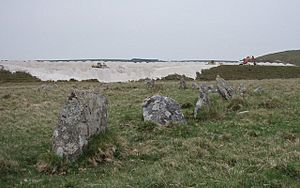Stannon stone circle facts for kids
 |
|
| Location | Bodmin Moor, Cornwall |
|---|---|
| Coordinates | 50°35′22″N 4°39′01″W / 50.589546°N 4.650258°W |
| Type | Stone circle |
| History | |
| Periods | Bronze Age |
Stannon stone circle (also known as Stannon circle) is an ancient stone circle located on Bodmin Moor in Cornwall, England. It's found near the village of St Breward. This special place shows us how people lived and gathered thousands of years ago.
What is Stannon Stone Circle?
Stannon gets its name from a farm nearby. It sits on a gentle hill called Dinnever Hill, between two small streams. The circle is about 4 kilometres (2.5 mi) southeast of Camelford. Even though there's a large china clay works nearby now, the circle still feels wild and peaceful. You're more likely to see moorland animals than people there!
The Stannon stone circle is a great example of an ancient Cornish ring. It has 47 stones standing upright, 30 stones lying down, and 2 that have moved. These stones are spread out in a large circle that is about 42.6 metres (140 ft) long and 40.5 metres (133 ft) wide. Most of the stones are about 0.5 metres (1.6 ft) tall. The biggest stone has a base that is over 1.2 metres (3.9 ft) wide.
Experts believe the circle was built during the late Neolithic period or early Bronze Age. This means it's thousands of years old!
Discoveries at Stannon Down
Archaeologists, who are like history detectives, have explored the area around Stannon Down. In the late 1960s, R. J. Mercer studied eight old round house sites. These houses were part of a larger settlement that might have had more than twenty homes. Each house was about 6 metres (20 ft) to 8 metres (26 ft) across.
The settlement covered an area of about 150 metres (490 ft) by 100 metres (330 ft). People living there also had fields for farming and rectangular areas that might have been used for keeping animals.
Scientists found that the area used to have many oak trees. People likely cleared some of these trees when they first settled there. The houses were built with wooden posts that held up thatched roofs. Inside, they had wooden walls, floors made of packed earth or stone, and even drainage systems.
Archaeologists found pottery and tools made of flint. They also found a whetstone, which is a tool used to sharpen metal blades. This suggests that people might have used metal tools back then.
It's thought that about one hundred people lived in this settlement. They lived during the Middle Bronze Age, which was a bit later than when the stone circle itself was built.
What Was the Circle Used For?
When you stand in the middle of Stannon Circle, you can see Rough Tor in the distance. Some researchers believe that these ancient monuments were built to line up with the sun's position at certain times of the year. This means people might have used the circle to mark important dates, like the sunrise on the longest or shortest day of the year.
Because of these special alignments and the nearby settlement, some experts call Stannon a "Ceremonial Complex." This means it was likely a very important place for ancient people to gather, perhaps for special events or rituals.


